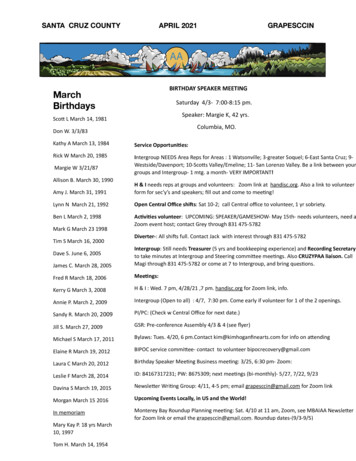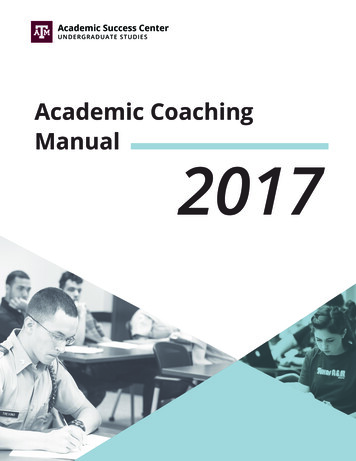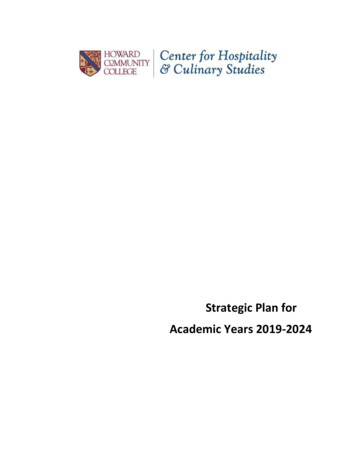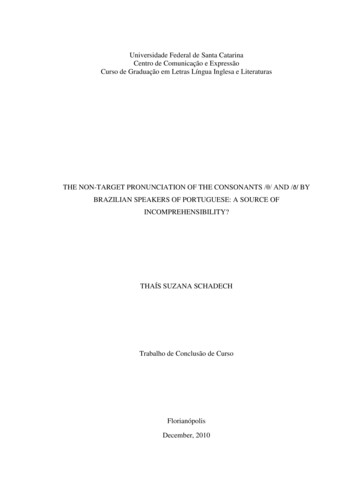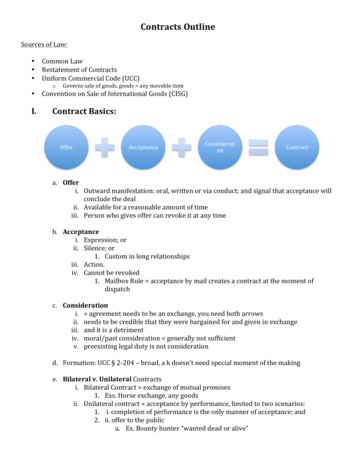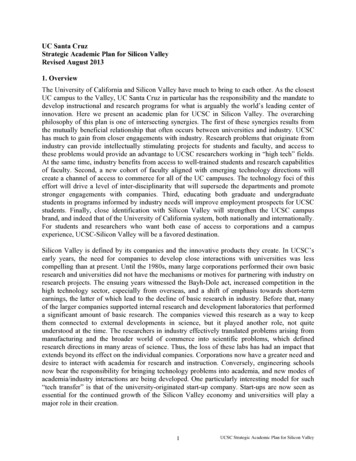
Transcription
UC Santa CruzStrategic Academic Plan for Silicon ValleyRevised August 20131. OverviewThe University of California and Silicon Valley have much to bring to each other. As the closestUC campus to the Valley, UC Santa Cruz in particular has the responsibility and the mandate todevelop instructional and research programs for what is arguably the world’s leading center ofinnovation. Here we present an academic plan for UCSC in Silicon Valley. The overarchingphilosophy of this plan is one of intersecting synergies. The first of these synergies results fromthe mutually beneficial relationship that often occurs between universities and industry. UCSChas much to gain from closer engagements with industry. Research problems that originate fromindustry can provide intellectually stimulating projects for students and faculty, and access tothese problems would provide an advantage to UCSC researchers working in “high tech” fields.At the same time, industry benefits from access to well-trained students and research capabilitiesof faculty. Second, a new cohort of faculty aligned with emerging technology directions willcreate a channel of access to commerce for all of the UC campuses. The technology foci of thiseffort will drive a level of inter-disciplinarity that will supersede the departments and promotestronger engagements with companies. Third, educating both graduate and undergraduatestudents in programs informed by industry needs will improve employment prospects for UCSCstudents. Finally, close identification with Silicon Valley will strengthen the UCSC campusbrand, and indeed that of the University of California system, both nationally and internationally.For students and researchers who want both ease of access to corporations and a campusexperience, UCSC-Silicon Valley will be a favored destination.Silicon Valley is defined by its companies and the innovative products they create. In UCSC’searly years, the need for companies to develop close interactions with universities was lesscompelling than at present. Until the 1980s, many large corporations performed their own basicresearch and universities did not have the mechanisms or motives for partnering with industry onresearch projects. The ensuing years witnessed the Bayh-Dole act, increased competition in thehigh technology sector, especially from overseas, and a shift of emphasis towards short-termearnings, the latter of which lead to the decline of basic research in industry. Before that, manyof the larger companies supported internal research and development laboratories that performeda significant amount of basic research. The companies viewed this research as a way to keepthem connected to external developments in science, but it played another role, not quiteunderstood at the time. The researchers in industry effectively translated problems arising frommanufacturing and the broader world of commerce into scientific problems, which definedresearch directions in many areas of science. Thus, the loss of these labs has had an impact thatextends beyond its effect on the individual companies. Corporations now have a greater need anddesire to interact with academia for research and instruction. Conversely, engineering schoolsnow bear the responsibility for bringing technology problems into academia, and new modes ofacademia/industry interactions are being developed. One particularly interesting model for such“tech transfer” is that of the university-originated start-up company. Start-ups are now seen asessential for the continued growth of the Silicon Valley economy and universities will play amajor role in their creation.1UCSC Strategic Academic Plan for Silicon Valley
Entrepreneurial activities are driven by interactions that are serendipitous, informal andimmediate, all of which are enhanced by geographical proximity between researchers andinvestors. For large corporations, geographical proximity can enable a type of interaction that isdifficult to achieve from a distance. Officers of such companies as Google, Oracle, eBay andApplied Materials have expressed an interest in hosting graduate students to conduct researchprojects at their companies. Thus we believe it is possible to turn the geographical proximity ofUCSC to Silicon Valley into an educational advantage, while retaining the primacy of being apublic educational institution.An additional reason for UCSC to expand its presence in Silicon Valley is to strengthen ourrelationship with NASA. UCSC manages a University Affiliated Research Center (UARC) andbenefits from management fee revenue. Perhaps more important than the financial benefit is thetremendous potential for increased interactions between NASA researchers and UCSC faculty.Continued operation of the UARC will require stronger research ties in the areas of earth andplanetary sciences, autonomous vehicles, data science and air-traffic control. With an enhancedpresence in Silicon Valley, UCSC can help NASA establish research collaborations with SiliconValley companies and be a more effective bridge between NASA and the other UC campuses.Growth of UCSC in Silicon Valley has been a long-term campus goal, and is consistent with the2008 UCSC Strategic Academic Plan1 and with important elements of the original 1963 LongRange Development Plan. In fact, one of the original planning premises on which the 1963LRDP was built was an “ongoing cooperation with the surrounding communities with the goal of‘mutually advantageous growth.’” Establishment of a UCSC campus site in Silicon Valleyfurthers such growth and cooperation. A Silicon Valley presence will also lead to further growthof graduate enrollments at UCSC, a primary goal of both the 2008 plan and of the recent“rebenching” program. Two of the key vision elements of the 2008 plan are to “serve the peopleof the region” and to commit to “high quality production and transmission of knowledge.” Thepresent plan addresses UCSC’s current lack of support for the people in the Silicon Valleyregion, and will enable high quality research and its dissemination. The TechnologicalDevelopment and Societal Impacts theme described in the 2008 plan is clearly applicable to allparts of the current plan for Silicon Valley. Also relevant are the three themes Human HealthInitiatives, Trans-nationalism and Globalism, and Evolving Environments, Science, and Policy.The 2008 plan concludes with a call for the growth of professional programs and professionalschools, which a presence in Silicon Valley will help achieve.This Silicon Valley plan is consistent with the Baskin School of Engineering’s updated academicplan and overall strategic vision, which includes growth of the departments to sizes that arecompetitive with other research universities and that are required to effectively engage withSilicon Valley companies on a variety of research topics. The BSOE’s vision also includesgrowth of research and instruction in new areas of high technology, including social networking,gaming, human-centered design and sustainability. By investing in both the existing programs on11965 UCSC Academic Plan page 16 - http://planning.ucsc.edu/sfc/PDFs/65-75 AcadPlan.pdf“The Santa Cruz campus will also undertake to provide graduate training for the scientific and engineeringpersonnel employed in the industrial complex of the Santa Clara Valley, possibly utilizing the proposed UniversityExtension Center at Sunnyvale.”2UCSC Strategic Academic Plan for Silicon Valley
the main Santa Cruz campus and in new programs on the Silicon Valley campus, the BSOE canexpand more readily without compromising the quality of the individual programs.Launching or relocating specific programs in Silicon Valley will alleviate some of the growthconstraints and limitations that we are experiencing on the Santa Cruz campus site. Althoughthere are a number of capital projects in the ten-year plan for the campus, it is unlikely that anyof those will move forward quickly enough to satisfy the needs of expanding academicprograms. Thus, in many cases, expansion(s) that would be impossible in Santa Cruz due tospace limitations would be made possible by expanding or relocating onto the Silicon Valleycampus site.Aspirational funds associated with rebenching will be leveraged to grow BSOE programs on themain campus, while a combination of funding sources will be used to grow the SV programs:aspirational funds, faculty research grants, industry-university partnerships, professional degreesupplemental tuition, and revenue from UNEX courses incorporated into the academic programs.The plan for Silicon Valley will leverage the existing infrastructure of University Extension(UNEX) for outreach and instruction. Some of the new programs, such as the Master’s Degree inElectrical Engineering, the Master’s in Technology and Information Management, and theEducation M.A. with teaching credential will more readily leverage existing UNEX courses, andin so doing can be rolled out more quickly and at a lower cost.UCSC has historically had a low proportion of graduate students relative to other UC campuses,due in part to the fact that we have very few professional master’s programs. Establishing apresence in Silicon Valley will allow the launch of a wide variety of professional master’sprograms whose graduates would be readily employable by local companies. Professionalmaster’s degree programs are often supported by supplemental tuition paid by the student, whichoffsets all or part of the cost of running the program. More information is provided in Section 5,Implementation Costs and Resources.Growth in Silicon Valley will also be of great benefit to our Ph.D. students, as it will allowgreater and deeper connections to cutting-edge companies. These companies can be the source ofintellectually challenging problems that stimulate our graduate students and form the core ofacademically rigorous dissertation research. These companies may also provide financial supportto our students and be interested in hiring our students. Our presence in Silicon Valley allows usto build a bridge for our students that connects academic instruction with real-world applications.In summary, several entities and individuals will benefit from the establishment of a new campussite in Silicon Valley. Among these beneficiaries are UC Santa Cruz faculty and students, theSilicon Valley community and workforce, the UC community and the UC Office of thePresident. Some of the advantages of expanding into Silicon Valley that we expect would appealin particular to UCOP include the following: UC programs would grow to reflect the economic growth of Silicon Valley over the pastseveral decades.Silicon Valley’s position as the pre-eminent center of innovation in the nation makesinvestment in instruction and research there a visible contribution by UCOP to3UCSC Strategic Academic Plan for Silicon Valley
California’s economy. Growth in Silicon Valley is the most compelling route towardsserving the local professional community in the Monterey Bay/San Jose region.The UCSC Baskin School of Engineering has matured to a size that will allow it tospearhead a Silicon Valley initiative.Access to Silicon Valley companies will become easier with a UC campus site nearby.The plan described in this document can be viewed as a UCOP plan to establish a centerfor instruction and research that would enable faculty at other UC campuses to developrelationships with companies, gain access to the most immediate and relevant technologyproblems for research, and enhance the placement of students in Silicon Valleycompanies.Expansion of our Ph.D. programs in fields relevant to Silicon Valley.An opportunity would exist for students to do their undergraduate degree at any UCcampus, and then come to UCSC Silicon Valley for an M.S. or M.Eng degree.The Santa Cruz campus will not build a standard complement of large-scale professionalschools such as medicine and law. However, the campus is considering creating a Schoolof Management, which could grow out of the Baskin School of Engineering’sTechnology and Information Management program, described below.Expansion into Silicon Valley will alleviate some of the space constraints, limitations andenrollment pressures on the Santa Cruz campus site.2. TimelineWe provide an extended timeline for program expansion on the Silicon Valley campus site. Werecognize the need to retain flexibility, which will allow continuing evolution of the campus overtime in response to changing demographics, societal needs, technological developments and newexternal challenges (1963 LRDP). This plan does not commit the BSOE or the campus to anyparticular timeframe for the individual components, nor is it intended to be a detailedimplementation plan. Each new academic program will be reviewed according to campus policypertaining to new program development. All new Professional Degree Supplemental Tuition(PDST) programs to be concentrated at the Silicon Valley campus will be subject to UCSC andsystemwide approval processes for new program development and for charging professionaldegree fees or self-supporting fees, which itself includes assessments of resource requirements,revenue, market demand surveys and analysis, enrollment projections, curriculum and courses ofstudy, and implementation plans. Individual new courses will be subject to standard campuscourse approvals. Academic and support units will be brought to Silicon Valley as the academicand research programs there grow.2.1 Initial Rollout: 2013-2016We propose a four-year rollout program for the Silicon Valley campus site. In essence, this isalready underway with the Technology and Information Management (TIM) program and theMaster’s Degree in Electrical Engineering (MSEE), both of which are administered by theBaskin School of Engineering and are presently offered at both the Silicon Valley and SantaCruz campus sites. The one other academic program to be rolled out in 2013 in Silicon Valleywill be the Master’s Degree in Games and Playable Media (GPM). Plans are also underway tolaunch two additional programs in 2014-2015 (Network Science & Engineering and Education),another in 2015-2016 (Data Science) and two programs in 2016 (Figure 1).4UCSC Strategic Academic Plan for Silicon Valley
Over the four-year rollout, we will track costs and revenues, learn from successes and failures,gauge demand for other programs, and ensure that the necessary infrastructure is in place beforeadditional programs are launched.Several of the BSOE academic programs to be concentrated at the Silicon Valley campus sitewill be supported by research institutes and centers. We envision that these centers will grow tobecome thriving research and teaching hubs, supporting a diverse community of students, facultyand industry collaborators. Centers planned for the 2013-2016 rollout include the Center forGames and Playable Media, the Data Science Institute, and the Network Sciences Institute.Discussions are also underway among BSOE Applied Mathematics and Statistics (AMS) facultyfor establishing a Research Institute for the Development and Application of Statistical andApplied Mathematics (RIAMS) in Silicon Valley in the next five years.2.2 Beyond the Initial Rollout: Years 2017-2020It will be important to remain flexible with respect to which academic programs are actualized inSilicon Valley over the next decade and beyond. Programs will form in response to a number ofvariables, including the emerging and evolving needs of the community, the state of Californiaand society, as well as academic areas of expertise identified by the campus. New areas of studymay form in response to new technologies or societal challenges. From our current vantagepoint, we envision that about two academic programs per year would emerge in the latter part ofthe decade (Figure 1, bottom), where the actual programs will depend on the build-out andsuccess of the earlier programs. Some of these are areas of research and teaching that alreadyexist on the main Santa Cruz campus, while others would be entirely new. Section 6 includesdescriptions of those programs that have been identified as solid candidates for presence inSilicon Valley, but other possibilities could arise.3. Enrollment ProjectionsOn average, UC engineering and computer science programs grow by approximately fivegraduate students for each FTE faculty. UC Santa Cruz has historically been somewhat belowthe average, but the BSOE student/faculty ratios are increasing, particularly in those areas inwhich we are projecting growth. Thus we expect that with the addition of 20 FTE, graduatestudent enrollment will grow by approximately 100. Going beyond this general statement, eachacademic program that expands onto the Silicon Valley campus will have its own enrollmentprojection(s). For example, the M.S. in Games and Playable Media program, which recentlyreceived systemwide approval, estimates a steady-state enrollment of 30 graduate students by2016. The Technology and Information Management (TIM) professional degree programestimates steady-state enrollment of 13 students by 2015. These numbers are based on acombination of factors, including anticipated faculty and lecturer hires, space allocations andprogram demand.5UCSC Strategic Academic Plan for Silicon Valley
4. GovernanceThe FTE envisioned for this plan will be situated in Silicon Valley and primarily appointed in theBaskin School of Engineering. These faculty will be governed in the same manner in which thefaculty situated at the Santa Cruz campus site are governed, with the same rights andresponsibilities regarding service, workload, personnel actions and contributions to education.FTE situated in Silicon Valley will be members of Academic Senate and be affiliated with aspecific department and division. They will undergo the same merit review process.Appointment, review and promotion of these FTE will be subject to APM and CAPMprocedures. These FTE will be subject to the campus’ standard instructional workload principlesand to their department’s specific workload policy. Recently, each of the BSOE departmentsupdated their policies to ensure equitable workload while allowing for flexibility based onprogram needs and faculty expertise. Many of the programs we propose to roll out initially at theSilicon Valley campus are graduate programs, and thus the instructional workload for the FTEassociated with these programs will necessarily be weighted towards graduate courses.BSOE FTE without a departmental affiliation are subject to the newly drafted schoolwideinstructional workload policy. This policy set workload standards for those of the individualdepartments, and we expect it could be used by other divisions on campus as they launch new ormove existing programs to the Silicon Valley campus site.6UCSC Strategic Academic Plan for Silicon Valley
We expect there will be no difficulty in applying the same rights and responsibilities to thefaculty at the Silicon Valley campus. A pilot program will either help confirm this, or it willsubstantiate a need for a separate campus-wide policy that defines the governance of SV faculty.5. Implementation Costs and ResourcesEach new program will have a unique set of resource requirements. Some may require severalnew FTE faculty, while others may need to add only one or two lecturers. Facilities, laboratoryrequirements, staffing and other operating expenses will also vary by program. Although thesevariations make it difficult to project total implementation costs for a full suite of 10-15 newprograms in Silicon Valley, we can estimate costs based on previous programs.Two newly approved academic programs to be located on the Silicon Valley campus offervaluable insight. Table 1 shows projected costs for the M.S. degree in Games and PlayableMedia (GPM) and the M.S. degree in Technology and Information Management (TIM), both ofwhich are Professional Degree Supplemental Tuition (PDST) pro
Education M.A. with teaching credential will more readily leverage existing UNEX courses, and in so doing can be rolled out more quickly and at a lower cost. UCSC has historically had a low proportion of graduate students relative to other UC campuses, due in part to the fact that we hav

